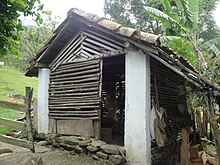Chicken coop
This article may require cleanup to meet Wikipedia's quality standards. The specific problem is: inaccurate, poor grammar, and missing citations. (October 2013) |

A chicken coop or hen house is a building where female chickens are kept. Inside hen houses are often nest boxes for egg-laying and perches on which the birds can sleep, although coops for meat birds seldom have either of these features.
A chicken coop usually has an indoor area where the chickens sleep and nest as well as an outdoor area where chickens will feed and spend the majority of the day. Inside the chicken coop are dropping boards or litter (such as straw) to collect chicken feces. A chicken coop should be cleaned every two to three weeks and the litter shifted every day, like a cat's litter box. A coop should be locked at night with all the chickens inside of it so that the chickens are protected from predators.
A coop may have an outdoor run. Both the inside and outdoor floors of a chicken coop are often strewn with a loose material such as straw or wood chips to deal with chicken droppings and to allow for easier cleanup.


Purpose
The purpose of a chicken coop is to protect chickens from bad weather - heat, cold, wind and rain. One method to protect chickens is to put an isolation material between two layers of wood or bricks. Because chickens don't like heat, windows should be oriented in such a way as to prevent overheating. Proper ventilation is also important to protect the chickens from overheating and infectious bronchitis. Another purpose for chicken coops is to protect the hens from predators--especially foxes and cats. The hens can be released outside by daylight but should be locked in a coop at night, as their predators generally hunt at night.
Housing controversies



There is a long-standing controversy over the basic need for a chicken coop. One philosophy, known as the "fresh air school" is that chickens are mostly hardy but can be brought low by confinement, poor air quality and darkness, hence the need for a highly ventilated or open-sided coop with conditions more like the outdoors, even in winter.[1] However, others who keep chickens believe they are prone to illness in outdoor weather and need a controlled-environment coop. This has led to two housing designs for chickens: Fresh-air houses with wide openings and nothing more than wire mesh between chickens and the weather (even in Northern winters), or closed houses with doors, windows and hatches which can shut off most ventilation.[2]
Backyard coops
Backyard coops are small and often enclosed within a fenced area (sometimes bounded by chicken wire) thus creating a more natural living environment, one in which the chickens can not only roam freely, but also peck and hunt for insects. If this kind of "yarding" is both floorless and reasonably mobile it is called a chicken tractor. Many people, especially those in rural areas, keep a small flock of chickens for themselves from which they harvest both eggs and meat.
The number of small chicken coops in urban areas of wealthy countries has been growing. This growth has led to the marketing of manufactured chicken coops, such as Eglu, which are designed for more cramped spaces and a tidier look. Manufactured chicken coops are primarily marketed towards urban chicken coop owners and are often more expensive than building one's own chicken coop.[3]
Urban settings may have laws which regulate any backyard farming of livestock. For example, Oakland, California, bans roosters[4] and has a rule stating that hens must be kept at least twenty feet away from dwellings, schools and churches.[5]
Other uses
- In American English the slang phrase flew the coop means someone who has fled before being sent to jail ("The police had a warrant for his arrest, so he flew the coop!").
- American truckers call weigh stations chicken coops.
- In the poem Ballad of John Silver by John Masefield there is a reference to drowning merchants "lamenting the absent chicken coop". In the age of sail, vessels on long voyages would often keep live poultry for meat and eggs within wooden coops stacked on deck. If a ship should sink or capsize these coops would typically come loose and float freely, making for an impromptu emergency floatation device. This maritime usage is archaic and may now be lost.
- A type of Soviet early warning radar were called Hen House by NATO.
See also
References
- ^ Woods, Prince T. (October 2008). "Fresh-Air Poultry Houses". Norton Creek Press. Retrieved 18 April 2012.
- ^ North and Bell, "Commercial Chicken Production Manual", 5th ed. Van Nostrand Reinhold, 1990, p 189.
- ^ "Deciding On Your Chicken Coop". Chicken Coops and Plans. Retrieved 18 April 2012.
- ^ "Animal Services". City of Oakland Animal Services. Retrieved 18 April 2012.
- ^ Skinner, Katy. "Chicken Laws". TheCityChicken.com. Retrieved 18 April 2012.
External links
- "More people turn to chickens as pets". USA Today. 20 July 2007.
- "Backyard chicken basics". University of Minnesota extension.
